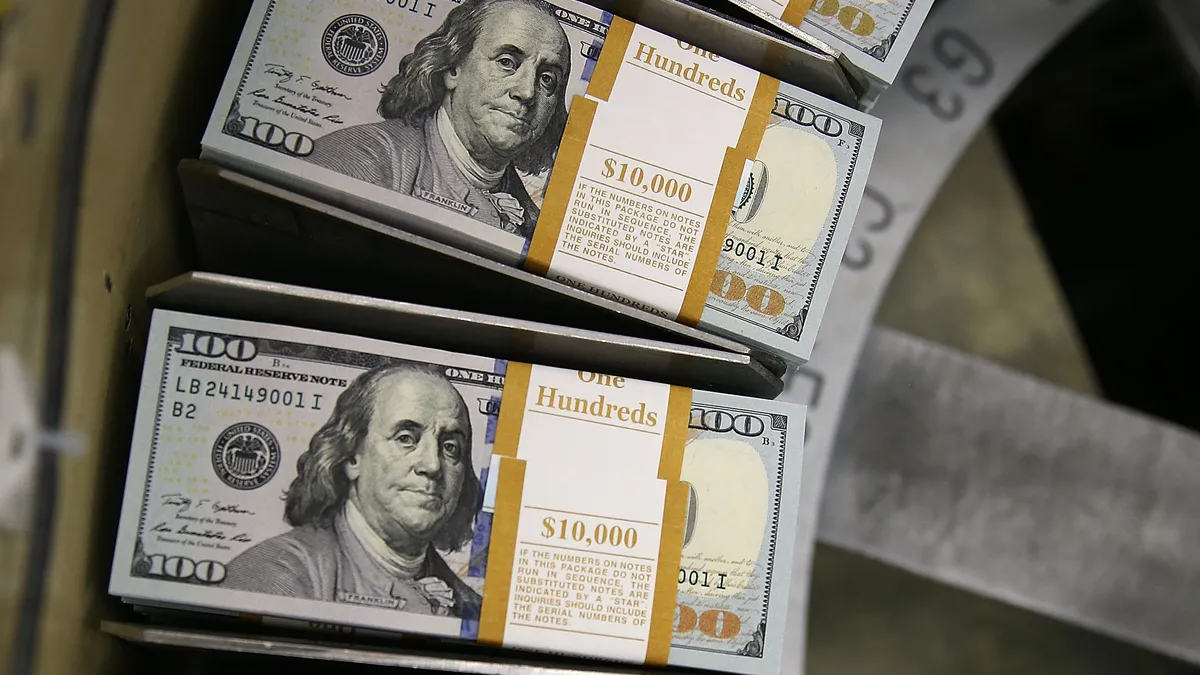Dive Brief:
- More than three out of four (77%) economic forecasters believe the highest inflation in four decades is either fueling a wage-price spiral or poses a “major risk” of doing so this year, the National Association for Business Economics (NABE) said Monday in its release of survey results.
- Rising wages, supply chain bottlenecks and shortages of materials prompted more than half of the forecasters to warn of “upside risks for inflation” in 2022, the NABE said. The week-long survey of 57 forecasters ended Feb. 15, several days before the start of Russia’s invasion of Ukraine pushed up prices for oil and other commodities worldwide.
- The forecasters “see a risk that inflation will remain higher than previously expected over the next three years, coming largely from the labor market,” according to David Altig, research director at the Federal Reserve Bank of Atlanta and NABE president.
Dive Insight:
CFOs and their C-suite colleagues at companies of all sizes face a threat that price pressures may upend a range of organizational efforts — from budgeting and curbing risk to forecasting and pricing.
Nearly three out of four Fortune 500 CEOs expect that the Federal Reserve will fail to quickly curb inflation under its currently expected pace for increases in the main interest rate, according to a survey by the Conference Board and Business Council.
Within the next 12 months, 72% of CEOs plan to pass along to consumers the rising costs of transportation and labor, according to the Jan. 17-31 survey of 133 CEOs, with 27% planning to do so within six months.
Small businesses are following the same path, with a higher percentage planning to raise prices than at any time since 1974, according to a survey last month by the National Federation of Independent Business (NFIB).
Increasing costs for inventory, supplies and compensation have spurred the price increases, along with the need to attract qualified employees in a tight labor market, the NFIB Chief Economist Bill Dunkelberg said.
The Fed’s preferred measure of price gains — the core personal consumption expenditures (PCE) price index — increased last month to a 38-year high of 5.2% compared with the prior year, the Labor Department said Friday. The central bank has set an inflation target of 2%.
The consumer price index (CPI) in January rose at a 7.5% annual rate, the fastest pace in four decades, according to the Labor Department.
Fed policy makers have indicated they plan to reduce stimulus when they gather for a two-day meeting ending March 16. They signaled in December an intent to begin raising the federal funds rate from a record low this year in at least three quarter-point increments to 0.875%.
NABE forecasters predict a stronger Fed tightening, with the main interest rate ending the year at 1.125%, an increase from their prediction in a December survey of 0.375%.
“What really struck me was obviously how analysts ramped up their projections for inflation,” Yulena Shulyatyeva, survey chair and a Bloomberg economist, said during a NABE webcast.
Since signaling a policy tightening in December, many Fed officials have made no efforts to puncture market expectations for as many as seven quarter-point increases in the benchmark rate this year.
“We probably won’t see seven rate hikes this year, and we will not see a 50 basis point hike in March,” Shulyatyeva said. The NABE expects that the Fed this month will raise the benchmark rate 0.25 percentage point, or 25 basis points.
NABE forecasters expect CPI to rise 3.6% this year. In December they predicted a 2.8% gain. They say core PCE will slow to 2.2% next year. Almost half (46%) of them predict core PCE will not decline to the central bank’s 2% target until 2024 or later.
The omicron variant of COVID-19 may have brought limited harm to the U.S. economy last month, with consumer spending rising 2.1% after falling 0.8% in December, the Commerce Department said Friday. Retail sales rose 3.8% in January and employers added 467,000 jobs.
Nevertheless, forecasters cut their estimate for inflation-adjusted growth at the end of this year to 2.9% from 3.6% in a December survey, NABE said. Nearly two-thirds of the forecasters say “the risks to their outlook are weighted on the downside,” NABE said, adding they expect growth will further slow next year.













